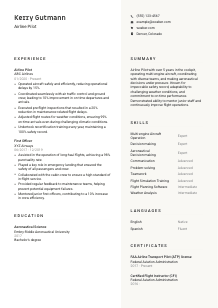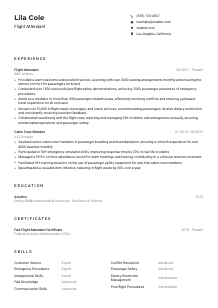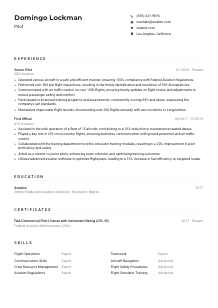Airline Pilot Resume Example
Solving intricate equations, but your resume doesn't add up? Explore this Math Teacher resume example, formulated with Wozber free resume builder. Discover how to integrate your mathematical mastery with job criteria, ensuring your career graph rises steadily as the curves you sketch!

How to write an Airline Pilot resume?
Hello, aspiring Airline Pilot! Standing out in the aviation field requires more than just having the right qualifications and flight hours; it's about clearly and compellingly showcasing your expertise on your resume. With the right approach, you can navigate through the competitive skies and land your dream job.
Leveraging Wozber's free resume builder, we'll guide you on a focused journey to tailor your resume specifically for an Airline Pilot position, ensuring ATS-compliance and making your application soar above the rest. Buckle up and let's take off towards creating a resume that truly reflects your professionalism and passion for flying.
Personal Details
The Personal Details section is your cockpit for making a first impression. It's not just a formality; it's your introduction to the hiring committee. Let's ensure your contact information is co-piloted with precision and aligns perfectly with the Airline Pilot role you're aiming for.
1. Your Brand Name
Your name, the captain of your personal brand, should soar at the top of the page. Make sure it's in a clear, professional font, slightly larger than the rest of your text, signaling your command of the skies and the resume.
2. Tailored Job Title
Directly beneath your name, align with your desired position by including "Airline Pilot," just as it appears in the job description. This immediate alignment shows you're laser-focused on the role.
3. Essential Coordinates
List your phone number and a professional email address (think firstname.lastname@email.com) to ensure clear skies for contact. Double-check for accuracy; you wouldn't want a typo to send your chances off-course.
4. Location, Location, Location
The job requires being in or relocating to Denver, Colorado. Including this in your contact details signals clear skies for your relocation or existing proximity, aligning with one of the fundamental requirements.
5. A Digital Horizon
Including your LinkedIn profile can extend your first impression beyond the resume. Just as in-flight instruments provide vital information, your LinkedIn offers a deeper look into your professional journey.
Takeaway
Your Personal Details section is the takeoff runway of your resume. Craft it with care to ensure a smooth lift-off for your job application. Remember, no detail is too small in the high-flying world of Airline Pilots; every piece of information should serve your journey to the interview.





Experience
The Experience section is where your career journey really takes flight. Here, you'll showcase not just where you've flown, but how you've excelled. Let's navigate through tailoring this crucial section to demonstrate your qualifications for the Airline Pilot role, with a focus on demonstrating compliance with FAA regulations, safety records, and teamwork.
- Operated aircraft safely and efficiently, reducing operational delays by 15%.
- Coordinated seamlessly with air traffic control and ground crew, leading to 10% improvement in on‑time departures and arrivals.
- Executed pre‑flight inspections that resulted in a 20% reduction in maintenance‑related flight delays.
- Adjusted flight routes for weather conditions, ensuring 99% on‑time arrivals even during challenging climatic conditions.
- Undertook recertification training every year, maintaining a 100% safety record.
- Assisted in the operation of long‑haul flights, achieving a 98% punctuality rate.
- Played a key role in emergency landing that ensured the safety of all passengers and crew.
- Collaborated with the cabin crew to ensure a high standard of in‑flight service.
- Provided regular feedback to maintenance teams, helping prevent potential equipment failures.
- Mentored junior first officers, contributing to a 10% increase in crew efficiency.
1. Chart Your Course
Analyze the job description and underline key experiences such as operating aircraft, coordinating with air traffic control, and participating in training. These are your navigational stars; let them guide your content.
2. Flight Log
Present your roles and the companies you've worked for in reverse chronological order. Ensure that your job titles and the duration of your flights (employment periods) are clearly marked, just like logbook entries.
3. Notable Achievements
Under each role, bullet-point your achievements, especially those that resonate with the job description. Mentioning how you "Operated aircraft safely, adhering to all FAA regulations" is akin to demonstrating your ability to navigate the skies safely and proficiently.
4. Quantify Your Flight Hours
Numbers stand out. For instance, stating you've "Reduced operational delays by 15%" quantifies your impact and showcases your efficiency in operations, making your accomplishments more tangible.
5. Mission-Relevant Skills Only
Tailor your listed experiences to the mission at hand. While your stint as a local flight instructor might be dear to you, focus on experiences that align with the scope of being an Airline Pilot, especially those involving multi-engine aircraft and team coordination.
Takeaway
Crafting an Experience section that's both reflective of your journey and tailored to the Airline Pilot role is like plotting a precise flight path. It requires attention to detail, relevance, and a clear understanding of the destination (the job). Quantify, clarify, and aim high – your career's flight plan depends on it.
Education
While the cockpit of an aircraft has its instruments, the Education section of your resume has its credentials. It's about more than the degrees; it's about showing your foundational knowledge and commitment to aviation. Here's how to ensure your education aligns with the trajectory towards becoming an Airline Pilot.
1. Match the Flight Plan
First, identify the core educational requirement from the job listing: a "Bachelor's degree in aviation, aeronautical science, or a related field." Your degree should be front and center, clear for easy navigation.
2. Degree Coordinates
List your degree, the field of study, and the institution where you earned it, followed by the graduation year. This straightforward format ensures the hiring manager can quickly scan your qualifications.
3. Degree Tailoring
If the job explicitly asks for a degree in a specific field, and you have it, make sure it's listed exactly as requested. For example, "Bachelor's degree in Aeronautical Science" perfectly aligns with the job's requests, showing you're exactly on course.
4. Relevant Coursework
Though not always necessary, listing relevant courses can add depth to your resume, especially early in your career. Including coursework in multi-engine operations or FAA regulations can further demonstrate your preparedness for the role.
5. Additional Achievements
Did you graduate cum laude? Are you part of an esteemed aviation organization? Such achievements speak volumes about your dedication and excellence in the field, adding flair to your educational journey.
Takeaway
Your Education section should not just comply with the job's requirements but also rise above them, showing your deep-rooted commitment and passion for the field of aviation. This section shines a spotlight on your formal training, paving the runway for your career to take flight.
Certificates
In aviation, certifications aren't just accolades; they're necessities that affirm your qualifications and expertise. This section of your resume is your chance to highlight specific certifications that not only meet the job requirements but also demonstrate your commitment to maintaining high standards.
1. Essential Certificates
Start with the certifications explicitly requested in the job description, like the "FAA Airline Transport Pilot (ATP) license." This direct match signals to the hiring manager that you meet the basic qualifications for the role.
2. Prioritize Relevance
After listing the essential certificates, include others that strengthen your candidacy, such as a "Certified Flight Instructor (CFI)" license if you have it. This shows a breadth of knowledge and an ongoing commitment to your profession.
3. Validity Dates
For certifications with expiration dates, ensure you include the date ranges. This transparency vouches for your certification's current validity, much like a flight plan confirms the route's clearance.
4. Continuous Learning
The aviation industry is ever-evolving, and so should you be. Regularly updating your certifications and staying abreast of new regulations demonstrate your dedication to being at the forefront of your field.
Takeaway
Your certificates serve as your flight credentials; they affirm your readiness and qualification for the responsibility of piloting aircraft. Highlighting both essential and supplementary certifications on your resume underlines your preparedness and enthusiasm for the role. It's a testament to your dedication to safety and excellence.
Skills
The Skills section of your resume is your personal avionics panel, showcasing the instruments and abilities you bring to the cockpit. Every skill listed should communicate to hiring managers that you're equipped and ready for the challenges of being an Airline Pilot. Let's dial in on how to make this section effectively convey your professional competencies.
1. Identify Relevant Avionics
Comb through the job description to unearth both the stated and implied skills required. Skills like "Multi-engine Aircraft Operation" and "Problem-solving" are your guiding stars here.
2. Highlight Your Instrumentation
Choose skills that directly resonate with the role. If "Communication" and "Teamwork" are listed in the job description, make sure they're prominently featured in your skills section.
3. Precision and Order
Keep your skills list focused and organized. A cluttered skills section can be as confusing as a cluttered cockpit, making it hard for hiring managers to see your qualifications. Stick to a clean, concise format to display your professional toolkit.
Takeaway
Your skills are your professional navigation aids, guiding you through your career's journey. Thoughtfully curated and clearly presented, they signal to employers that you're well-equipped for the Airline Pilot role, ready to take the controls and contribute to successful missions. Keep honing these skills to stay sharp and prepared for any challenge.
Languages
In the global arena of aviation, communication is key. Your ability to speak different languages can distinctly advantage your application, especially in international operations. This section is your chance to showcase linguistic proficiency as part of your professional pilot's toolkit.
1. Mandatory Tongues
The job outline specifies "Proficient English speaking and listening skills." Therefore, your language proficiency in English should take the lead in this section, clearly evidencing your capability to meet this core requirement.
2. Showcase Your Linguistic Fleet
After listing English, include any other languages you speak. Your ability to communicate in multiple languages can be a significant asset, demonstrating your versatility and potential to engage with diverse teams and passengers.
3. Gauge Your Proficiency
Be honest about your language levels. Whether you're "Native," "Fluent," "Intermediate," or possess basic knowledge, clarity here ensures smooth communications down the line, akin to clear air traffic control.
4. The Universal Language of Aviation
Remember, aviation has its own universal language. Highlighting your expertise in aviation-specific communication can be as crucial as traditional language skills, showcasing your ability to navigate international skies.
5. Consider The International Routes
If the role involves or could involve international routes, your multilingual skills become even more valuable. Even if not explicitly mentioned, demonstrating your readiness for global operations can distinguish your application.
Takeaway
Your languages section is a reflection of your ability to communicate and connect in a global industry. Each language you speak is a runway to new cultures, experiences, and professional interactions. While English may be the air traffic control of aviation, your multilingual abilities underscore your capacity to navigate the skies and ground relations with ease and proficiency. Keep exploring, learning, and communicating!
Summary
The Summary section is your resume's cruising altitude, offering a broad view of your career landscape while conveying your direction and altitude. This concisely written segment propels the hiring manager into your career flight path, highlighting how your experience, skills, and qualifications make you the ideal candidate for the Airline Pilot position.
1. Aviation Overview
Start with a bird's-eye view of your aviation career. Whether you've been ascending through the ranks or you've steadily held course in turbulent skies, this is where your narrative begins. Mention your years of experience and the breadth of your flight operations.
2. Core Competencies
List a few standout skills or experiences that directly relate to key job requirements. For instance, noting your "impeccable safety record" directly mirrors the priority the job description places on safety and adherence to FAA regulations.
3. Your Unique Trajectory
Highlight any unique contributions or achievements in your career. Have you led a team through a crisis? Innovated in flight operations? Your summary is the place to showcase these distinguishing flights.
4. Keep It Tight
Like a carefully packed flight bag, your summary should contain only what's necessary. Aim for 3-5 impactful sentences that encapsulate why you're the perfect candidate, ensuring readability and immediate interest.
Takeaway
Your Summary is the compass of your resume, directing the reader through your professional journey and pointing towards why you're the right pilot for the job. Craft it with precision, focusing on your career highlights and how they align with the job's requirements. Let it showcase your ability to navigate not just the skies but also the career ladder, making a compelling case for your candidacy.
Launching Your Airline Pilot Journey
Congratulations on meticulously charting your course through the details of crafting an unparalleled Airline Pilot resume. With Wozber's free resume builder, including ATS-friendly resume templates and the ATS resume scanner, you're equipped with the tools needed to ensure your resume is not only seen but stands out. Your next destination? Submitting an application that showcases your expertise, dedication, and readiness to soar in the role of an Airline Pilot.
The skies beckon, Pilot; it's time to navigate your career to new altitudes. Fly high, and here's to clear skies and tailwinds on your journey to success!

- Bachelor's degree in aviation, aeronautical science, or a related field.
- FAA Airline Transport Pilot (ATP) license.
- Minimum of 1, 500 flight hours with significant time in multi-engine aircraft.
- Strong communication and teamwork skills.
- Problem-solving and decision-making abilities under pressure.
- Proficient English speaking and listening skills necessary.
- Must be located in or willing to relocate to Denver, Colorado.
- Operate aircraft safely and efficiently, adhering to all FAA regulations and company policies.
- Perform pre-flight inspections to ensure the aircraft is in optimal condition and report any discrepancies or maintenance needs.
- Coordinate with air traffic control and ground crew to ensure smooth operations during takeoff, flight, and landing.
- Stay updated with current weather conditions, adjusting routes as necessary for safety.
- Participate in regular training and recertification to maintain licensure and stay abreast of industry changes.















